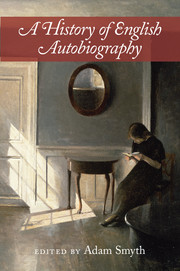Book contents
- Frontmatter
- Dedication
- Contents
- List of contributors
- 1 Introduction: The range, limits, and potentials of the form
- PART 1 AUTOBIOGRAPHY BEFORE ‘AUTOBIOGRAPHY’ (CA. 1300–1700)
- PART 2 RELIGION, GENDER, THINGS (CA. 1700–1800)
- PART 3 THE MANY NINETEENTH CENTURIES (CA. 1800–1900)
- 12 Working-class autobiography in the nineteenth century
- 13 Romantic life-writing
- 14 Nineteenth-century spiritual autobiography: Carlyle, Newman, Mill
- 15 Emerging selves: The autobiographical impulse in Elizabeth Barrett Browning, Anne Thackeray Ritchie, and Annie Wood Besant
- 16 Victorian artists’ autobiographies: Transgression, res gestae, and the collective life
- 17 Victorian print culture: Periodicals and serial lives, 1830–1860
- PART 4 RELATIONAL LIVES AND FORMS OF REMEMBERING (CA. 1890–1930)
- PART 5 KINDS OF COMMUNITY (CA. 1930-CONTEMPORARY)
- Index
- References
16 - Victorian artists’ autobiographies: Transgression, res gestae, and the collective life
from PART 3 - THE MANY NINETEENTH CENTURIES (CA. 1800–1900)
Published online by Cambridge University Press: 05 March 2016
- Frontmatter
- Dedication
- Contents
- List of contributors
- 1 Introduction: The range, limits, and potentials of the form
- PART 1 AUTOBIOGRAPHY BEFORE ‘AUTOBIOGRAPHY’ (CA. 1300–1700)
- PART 2 RELIGION, GENDER, THINGS (CA. 1700–1800)
- PART 3 THE MANY NINETEENTH CENTURIES (CA. 1800–1900)
- 12 Working-class autobiography in the nineteenth century
- 13 Romantic life-writing
- 14 Nineteenth-century spiritual autobiography: Carlyle, Newman, Mill
- 15 Emerging selves: The autobiographical impulse in Elizabeth Barrett Browning, Anne Thackeray Ritchie, and Annie Wood Besant
- 16 Victorian artists’ autobiographies: Transgression, res gestae, and the collective life
- 17 Victorian print culture: Periodicals and serial lives, 1830–1860
- PART 4 RELATIONAL LIVES AND FORMS OF REMEMBERING (CA. 1890–1930)
- PART 5 KINDS OF COMMUNITY (CA. 1930-CONTEMPORARY)
- Index
- References
Summary
Despite increasing attention paid to autobiographies, artist autobiographies have largely been ignored by scholars of the genre. Art historians have examined life writings of William Holman Hunt, Benjamin Haydon, and some women artists, but unique features of Victorian artist autobiographies become apparent when more texts are read collectively and in relation to Victorian autobiographies in general. Artists such as William Holman Hunt, Elizabeth Butler, William Powell Frith, and Henrietta Ward wrote from contradictory positions: once extremely successful, they published their autobiographies after the decline of their markets and reputations. Painfully aware of such fluctuations, artists sprinkled their texts with stories of failed or mad artists or those who died young, countering their narratives of success, to expose the capricious social and market forces that directed their careers. They invoked the res gestae mode – digressive non-sequiturs, gossip, and anecdotes – which they strategically deployed to reveal the speculative and contingent nature of artistic life and to recall the imaginary community of their former professional and social cohorts. The res gestae memoir was ‘distinct from the developmental autobiography’ due to its use of ‘recollection and reminiscence as the bases of its form’ (Peterson 1990, 183). Bernd Neumann has further articulated this mode as an external orientation, the individual acting as a social being, as distinguished from the narrative of memory and identity, which constitutes a more internal focus. He identifies res gestae with the memoir, while memory and identity belong to autobiography. Among historians, the phrase refers to a type of history that narrates accomplishments and structures narrative around events.
Artists’ autobiographies, the term they used for their narratives, deployed the res gestae mode in these several ways. Artists bragged about their accomplishments, organised their narrative around career events, and represented themselves as social beings. Their networks, social events, and sociability reflected their need to attract patrons among the well-to-do, create friendships with critics and other artists, and build a clientele in which social and economic spheres overlapped. Unlike Victorian spiritual autobiographies, artists were rarely introspective. William Bell Scott described his autobiography as having ‘little introspection’ and focusing on ‘the lives of my dear and intimate friends’ (Scott 1892, 4–5). Most artists were intrepid travellers due to traditional ties between art making and travel: this included sketching tours, trips to Italy, and commissions abroad.
- Type
- Chapter
- Information
- A History of English Autobiography , pp. 221 - 236Publisher: Cambridge University PressPrint publication year: 2016

